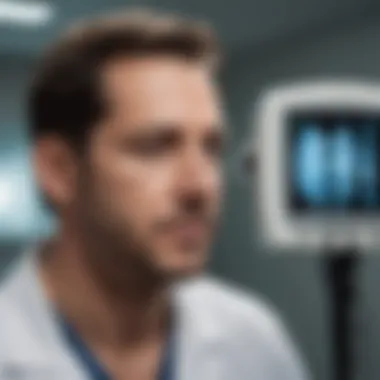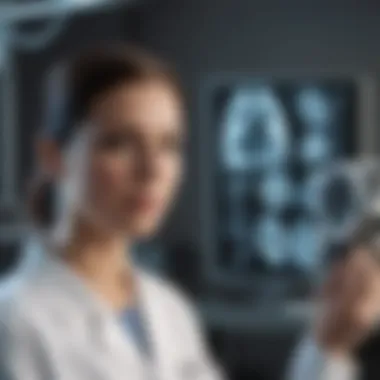Unveiling the Pivotal Role of Radiologic Technicians in Modern Healthcare


Market Insights
Radiologic technicians are at the forefront of embracing these technological changes, adapting their skills to enhance the precision and speed of diagnostic procedures.
Economy Insights
The economic indicators and metrics surrounding the field of radiologic technology reflect promising growth prospects. Government policies aimed at expanding access to healthcare services contribute to the rising demand for diagnostic imaging. Globally, news of increased investment in healthcare infrastructure further underscores the significance of radiologic technicians in the broader economic landscape.
- Market Analysis and Predictions: Analyses suggest a steady increase in the market demand for radiologic technicians, mirroring the expanding healthcare industry.
Investment Strategies
In considering investment strategies related to the domain of radiologic technology, portfolio diversification emerges as a prudent approach. As technological innovations continue to shape the healthcare sector, investing in companies focused on medical imaging devices and equipment can be a strategic move. Risk management techniques can include monitoring regulatory changes and market dynamics to mitigate potential uncertainties.
- Exposure to diverse sectors within healthcare can buffer against volatility in any specific niche.
Personal Finance Tips
For individuals seeking personal finance tips within the realm of healthcare careers, budgeting and saving strategies tailored to long-term educational investments can be beneficial. Retirement planning guidance that accounts for the evolving nature of healthcare technology can ensure financial security post-career. Debt management tips focused on efficiently leveraging educational loans for skill development underscore the value of strategic financial planning.
- Retirement Planning Guidance: Considering the long-term financial implications of training and education can provide a stable foundation for future financial health.
Case Studies and Success Stories
Real-life case studies and success stories within the field of radiologic technology serve as inspiration for budding professionals. By exploring the journeys of successful radiologic technicians, individuals can gain valuable insights into career progression and the impact of specialization. These narratives not only offer practical examples but also highlight the transformative power of dedication and expertise.
Personal Finance Transformation Journeys showcase the real-world outcomes of strategic financial decisions intertwined with career development luminously.
Prologue


The domain of modern healthcare stands as a harmonious symphony, where every component, no matter how subtle, plays a vital role in the melody of wellness. In this intricate ecosystem, The Vital Role of a Radiologic Technician emerges as a focal point radiating significance and influence. Radiologic Technicians, sculptors of medical insight through imaging, embody a unique blend of precision, expertise, and empathy within the healthcare landscape.
Radiologic technicians, also known as X-ray technologists, serve as the backbone of diagnostic imaging, lending eyes to the invisible and formless intricacies within the human body. Their mastery directs the path to accurate diagnoses, enabling treatment plans to be sculpted with finesse. Through the lens of imaging technologies, such as X-rays, MRIs, and CT scans, they decipher the cryptic language of medical conditions into tangible visuals, bringing clarity where shadows once lingered.
Intricately intertwined with the narrative of patient care, radiologic technicians are custodians of empathy and reassurance. As they guide individuals through the technicalities of imaging procedures, they nurture a human connection that transcends the cold veneer of machinery. Every scan they perform, every image they capture, is a brushstroke in the portrait of healthcare, detailing stories of resilience, hope, and healing.
The realm of diagnostic imaging pulsates with continual evolution, propelled by technological advancements and the unwavering dedication of professionals like radiologic technicians. As we delve deeper into the labyrinth of modern healthcare, their role emerges not just as crucial but as transformational, shaping the foundations of patient-centered care and medical accuracy. The silhouette of a radiologic technician within the vast expanse of healthcare is one defined by quiet mastery and profound impact, a testament to their indispensable value in safeguarding human health and well-being.
Understanding Radiologic Technicians
Radiologic technicians play a fundamental role in modern healthcare, where the demand for diagnostic imaging continues to rise. This section aims to provide a detailed exploration of the responsibilities, skills, and importance of radiologic technicians in the healthcare ecosystem. By shedding light on various aspects of their profession, we aim to underscore their significant contributions to patient care and medical diagnosis.
Definition of Radiologic Technician
A radiologic technician, also known as a radiologic technologist, is a vital healthcare professional responsible for performing diagnostic imaging examinations, including X-rays and computed tomography (CT) scans. These highly trained individuals operate sophisticated imaging equipment to help physicians diagnose and treat medical conditions effectively. Radiologic technicians must adhere to stringent safety protocols to minimize radiation exposure risks for both themselves and patients.
Role in Diagnostic Imaging
Radiologic technicians play a pivotal role in diagnostic imaging by executing imaging procedures requested by physicians to aid in accurate diagnosis and treatment planning. They collaborate closely with radiologists, medical professionals specialized in interpreting medical images, to ensure the quality and accuracy of imaging studies. By producing high-quality images, radiologic technicians enable healthcare providers to make well-informed decisions regarding patient care.
Educational Requirements
Becoming a radiologic technician entails completing a formal educational program accredited by the Joint Review Committee on Education in Radiologic Technology (JRCERT). These programs typically lead to an associate or bachelor's degree in radiologic technology and include hands-on clinical experience in various healthcare settings. Additionally, radiologic technicians must obtain state licensure or certification to practice legally, ensuring adherence to professional standards and competency in the field.
Skills and Competencies
In this crucial exploration of the vital role of Radiologic Technicians in modern healthcare, the focus shifts towards understanding the pivotal significance of Skills and Competencies within this specialized field. These underpinning abilities form the cornerstone of effective diagnostic imaging practices, bridging the gap between technology and patient care.
Excellence in Technical Proficiency Radiologic Technicians must demonstrate a profound mastery of technical operations within diagnostic imaging equipment. This proficiency covers a wide array of modalities such as X-ray, MRI, CT scans, and more. The seamless operation and troubleshooting of these sophisticated machines rely heavily on the technician's technical acumen and adaptability to evolving technologies.
Delve deeper into the nuances of Technical Proficiency, highlighting the critical nature of staying abreast of advancements in radiologic technology, expanding skill sets to encompass emerging modalities, and ensuring optimal functionality of imaging equipment for precise diagnostic outcomes.


Diligent Attention to Detail Attentiveness to detail stands as a foundational pillar in the work of Radiologic Technicians. The slightest deviation in imaging protocols or oversight in positioning can significantly impact diagnostic accuracy. Through meticulous attention to every step of the imaging process, these professionals ensure the quality and reliability of diagnostic images, enabling accurate interpretation by radiologists.
Discuss the intricate interplay between Attention to Detail and diagnostic precision, emphasizing how a keen eye for anomalies, proper patient identification, and adherence to safety protocols collectively contribute to the overall efficiency and efficacy of diagnostic imaging procedures.
Nuanced Interpersonal Skills While technical prowess is imperative, Radiologic Technicians also rely on finely honed interpersonal skills to interact effectively with patients, radiologists, and other healthcare professionals. Compassionate communication, active listening, and empathy are vital components in fostering a reassuring and collaborative environment during diagnostic procedures.
Emphasize the human element in the practice of Radiologic Technicians, shedding light on how strong interpersonal skills enhance patient comfort, facilitate accurate image acquisition through precise instructions, and strengthen interdisciplinary cooperation for comprehensive patient care.
Importance of Radiologic Technicians
Radiologic Technicians play a pivotal role in the modern healthcare landscape. Their expertise in diagnostic imaging is indispensable for accurate disease identification and treatment planning. Without these professionals, the entire process of patient care and diagnosis would be significantly compromised. By operating complex equipment and collaborating closely with radiologists, radiologic technicians ensure that medical images are of the highest quality and clarity. Their meticulous attention to detail and technical proficiency is unmatched, making them essential components of any healthcare institution.
Critical Component in Healthcare
Radiologic Technicians are not just support staff; they are critical components of the healthcare system. Their role directly impacts patient outcomes and treatment efficacy. The ability to perform imaging procedures with precision and accuracy is fundamental in guiding physicians towards informed decision-making. From detecting fractures to locating tumors, radiologic technicians enable timely interventions that can be life-saving. Without their expertise, the diagnostic process would be incomplete, leading to delayed treatments and potential health risks for patients.
Enhancing Diagnostic Accuracy
One of the primary contributions of radiologic technicians is enhancing diagnostic accuracy. Through their specialized training and experience, they ensure that medical images are captured correctly and with the utmost detail. This accuracy is paramount in identifying subtle abnormalities that might go unnoticed by the untrained eye. By producing high-quality images, radiologic technicians empower radiologists to make accurate diagnoses and formulate effective treatment plans. Their role in increasing diagnostic precision cannot be overstated, as it directly influences patient care and outcomes.
Collaboration with Radiologists
Collaboration between radiologic technicians and radiologists is a synergistic relationship that drives optimal patient care. Radiologic technicians provide essential support to radiologists by preparing patients for procedures, positioning them correctly for imaging, and obtaining diagnostic images of the highest caliber. This collaboration streamlines the diagnostic process, allowing radiologists to focus on interpreting images and delivering accurate diagnoses. The seamless teamwork between these professionals leads to improved efficiency in healthcare delivery and ultimately enhances patient experiences and outcomes.
Challenges and Opportunities
Radiologic technicians face a plethora of challenges and opportunities in the dynamic landscape of modern healthcare. These crucial elements not only shape their daily work environment but also influence the future direction of the profession. Understanding these factors is imperative for both professionals in the field and stakeholders looking to invest in this sector.
Technological Advancements
Technological innovations play a pivotal role in revolutionizing the field of radiologic technology. Advancements in imaging techniques and equipment have greatly enhanced the accuracy and efficiency of diagnostic procedures. From the introduction of digital imaging to the development of artificial intelligence algorithms for image interpretation, technology continues to mold the way radiologic technicians operate. Staying abreast of these advancements becomes essential for technicians to deliver quality patient care and maintain their competitive edge in the industry.


Professional Development
The pursuit of continuous learning and skill enhancement paves the path for professional growth among radiologic technicians. Engaging in ongoing training programs, pursuing advanced certifications, and expanding knowledge in emerging areas of radiology are indispensable for staying relevant in the ever-evolving healthcare realm. Investing in professional development not only benefits the individual technician but also elevates the standards of patient care and diagnostic excellence across the board.
Patient Care Evolution
The evolution of patient care standards underscores the evolving role of radiologic technicians in healthcare. Beyond technical acumen, technicians must cultivate a patient-centered approach, focusing on empathy, communication, and ethical practice. As the healthcare landscape shifts towards holistic care, radiologic technicians must adapt their practices to meet the rising expectations for compassionate, personalized patient experiences.
The Future of Radiologic Technicians
Radiologic technicians play a pivotal role in the landscape of modern healthcare, with their significance only set to grow in the coming years. As we peer into the horizon of this profession, several key elements come into focus, shedding light on the path that lies ahead.
Emerging Trends
In the realm of radiologic technology, emerging trends are shaping the way healthcare is delivered. From the widespread adoption of artificial intelligence to the integration of 3D printing in medical imaging, the future heralds a wave of innovation that promises to revolutionize diagnostic processes. Radiologic technicians must adapt to these advancements, embracing new technologies to enhance their practice and provide advanced care to patients.
Professional Advancements
The field of radiologic technology is dynamic, with continuous professional advancements paving the way for enhanced patient care. With specialized certifications, such as in MRI or CT scanning, radiologic technicians can expand their skill set and offer more specialized services. Moreover, opportunities for career growth, such as becoming a lead technologist or transitioning into education or research roles, present avenues for professional development and personal fulfillment.
Impact on Healthcare Systems
The evolving role of radiologic technicians reverberates across healthcare systems, fostering improvements in efficiency, accuracy, and patient outcomes. By facilitating timely and accurate diagnostic procedures, these professionals contribute to streamlined care pathways and informed treatment decisions. Additionally, their collaboration with radiologists and other healthcare providers ensures a holistic approach to patient management, enhancing overall healthcare delivery.
Culmination
In the realm of healthcare, the Conclusion serves as the pivotal juncture where all the threads of this narrative convene. This section encapsulates the essence of the Vital Role of a Radiologic Technician in modern healthcare, delineating a tapestry of significance and impact.
Amidst the intricate tapestry of healthcare dynamics, the Conclusion emerges as a beacon of clarity and reassurance to both professionals in the field and the broader audience keen on understanding the nuances of radiologic technology. It underscores the profound implications of the radiologic technician's role, not merely as a technician but as a linchpin in the diagnostic machinery that propels medical intervention and patient care to new heights.
The Conclusion employs a mosaic of key elements essential to the cohesive functioning of healthcare systems globally. It accentuates the nuances of patient care, diagnostic accuracy, and collaborative teamwork that define the Radiologic Technician's indispensable contribution.
In dissecting the landscape of professional nuances within radiologic technology, the Vital Role of a Radiologic Technician engenders a deep dive into the nuanced layers of competence and proficiency required in the domain. This reveals a multidimensional narrative that extends beyond routine diagnostic procedures, resonating with the evolving landscape of healthcare delivery.
A driving consideration of the Conclusion lies in shedding light on the evolving trends shaping radiologic technology. It navigates the flux of advancements and challenges, presenting a comprehensive outlook on the trajectory of radiologic technicians in an ever-evolving healthcare paradigm.
Therefore, the Conclusion outlines a roadmap towards a more robust healthcare ecosystem, underlining the indispensable reliance on the expertise and diligence of radiologic technicians. Their role reverberates far beyond imaging machines, encapsulating the spirit of meticulous care and medical precision that defines modern healthcare endeavors.



